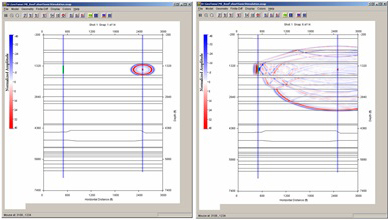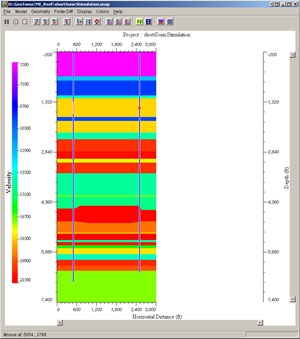Sonic stimulation technology has the potential to provide a low-cost procedure for enhancing oil recovery in depleted fields and making it economically feasible to return some abandoned wells to production. Tests of the technology indicate that sonic stimulation technology potential is greatest in fields with a high water cut and large amounts of immobile oil, making the technology suitable for mature domestic oil fields. Field tests with different seismic sources, however, have yielded promising but mixed or inconclusive results for enhancing oil production. In some cases seismic stimulation was reported to increase production rates by 50%, but in other cases production was unchanged or actually declined.
The theoretical foundation for sonic stimulation is currently not well-constrained by observational data from field experiments. While some laboratory experiments have been conducted, their applicability to field conditions is not clear.
Project Results
In conjunction with Baker Atlas Inc., Michigan Tech devised a system capable of recording the earth motion and pressure due to downhole and surface seismic sources. Four seismic sources were tested at Michigan Tech's Reservoir Characterization Test Site to determine the distance the seismic waves would travel.
A second focus of the study was to gain an understanding of the fundamental physical mechanisms of the effect of sonic stimulation on oil mobilization. A theory has been developed to account for the behavior of oil drops (ganglia) trapped in pore throats and their ultimate release through the additional incremental pressure associated with sonic stimulation.
Based on the capillary mechanisms determined for oil mobilization, the following criteria were outlined for successful seismic stimulation.
- The shallower the reservoir, the stronger the effect.
- Waterflooded reservoirs with water saturation greater than 90%.
- The lower the oil viscosity, the better the result.
- Optimal (resonant) frequencies should be selected (frequencies above a certain threshold may be inefficient).
Benefits
This work provides a physically based theoretical model that can be used to improve the performance, reliability, and predictability of new or improved sonic sources. The permanent test well and the downhole sonde will provide a test site so that other sonic sources can be developed and tested. Criteria for reservoirs most likely to benefit from sonic stimulation were delineated.
This project's success could pave the way to supporting the application of a low-cost method to enhance oil recovery, which could revitalize many oilfields across the Nation and add domestic reserves and production.
Project Summary
The purpose of this project was to establish the place, procedures, and hardware necessary for rigorous far-field measurement of seismic signals (elastic waves). The essential elements of the Baker Atlas-Michigan Tech system are 1) a borehole test site that will remain unchanged and is available to test sonic sources; 2) a downhole sonde that will itself remain in place and, because of its downhole digitization features, does not require the wireline or surface recording components to remain constant; and 3) a set of procedures that ensures that the amplitude and frequency parameters of a wide range of sources can be compared with confidence.
Four seismic sources were deployed at Michigan Tech's Reservoir Characterization Test Site to record and measure the signal strength of a single activation of the sources. To make source-to-source comparisons, every parameter of the tests was kept constant except for the source. Three of the sources tested were downhole sources, and one was a surface source. The downhole sources included one piezo-electric vibrator and two oscillating water-jet types of tools. The surface source was a small hydraulic vibrator.
The sources were recorded by a downhole receiver containing calibrated three-component geophones and hydrophones. The seismic traces were analyzed in the time domain and in the frequency domain. The three downhole sources could not be detected above the ambient noise levels of the site in the time domain, but the surface source was easily observed, making it the best source tested for sonic stimulation. The surface source, the downhole piezo-electric vibrator, and one of the downhole water-jet sources could be observed in the frequency domain. The frequency band of the sources varied from a low of 18 Hz (the low end of the surface vibrator) to a high of 1,600 Hz (the high end of the downhole piezo-electric source).
The mechanism proposed for sonic stimulation is capillary entrapment of oil. Residual oil is trapped in a pore because of the resisting capillary forces that prevent free motion of a non-wetting fluid. A finite, external-pressure gradient, exceeding the "capillary-barrier" threshold, needs to be applied to carry the ganglia through the pore throat. The application of vibrations is equivalent to the addition of an oscillatory force to the constant pressure gradient within the rock pore system. When this extra force acts along the gradient and the threshold is exceeded, instant "unplugging" occurs, and the oil blob may move through the pore throat.
The criteria of a ganglion's mobilization involve the parameters of both the medium (pore geometry, interfacial tension and wetting properties, and fluid viscosity) and the oscillatory field (amplitude and frequency). The medium parameters vary widely under natural conditions. It follows that an elastic wave with a given amplitude and frequency will always mobilize a certain subpopulation of ganglia while leaving others intact; in this sense, the vibratory field always will produce a certain mobilization effect. The exact macroscopic effect nonetheless will be hard to predict, as it will represent a cumulative response of the populations of ganglia with unknown parameter distributions. Variability of reservoir response to vibratory stimulation thus should be expected.






